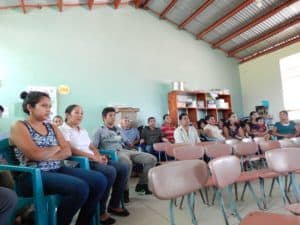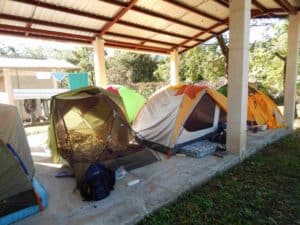
November 22, 2014
She hasn’t had a good night sleep since coming to Honduras. It isn’t sleeping in a tent on a concrete floor under the stars. The tent, after all, is placed over a semi soft mattress. It’s not the time change, only an hour’s difference. The tropical warmth doesn’t seem to bother her, even though she does live in Wyoming and it is mid-November. Those squirmy and crawly things are close by, but she’s not the type to jump up on a chair at the threat of a mouse. What is it then that keeps her awake half the night? She had once been told, and always believed it to be true, that roosters only crow to greet the sunrise. Actually, and this is not scientifically proven, roosters crow because they abhor silence, beginning their wrenching screams sometime around midnight and only slowing down sometime after dawn. Unfortunately, here in the frontier region of Intibucá, in the small village of Agua Salada, this tone-deaf choir outnumbers the human population by at least three to one.
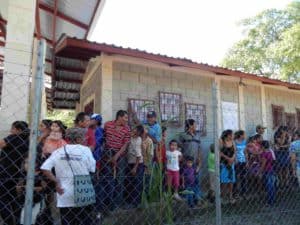
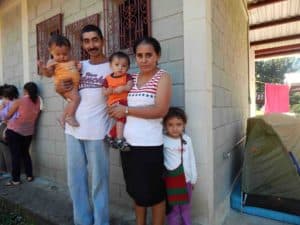
On Tuesday she is dragging a little bit. Perhaps that’s why the brigade leaders have given her light duty, fitting and distributing reading glasses. Still, when it’s real slow, she might be asked to assist with an injection or minor surgery. On occasion the pharmacy gets busy and she’s called over to fill prescriptions. On Monday, one of the leaders guessed that they saw about 120 patients. Perhaps everyone had shown up on the first day, but on Tuesday there are actually more. The word must be traveling to the more outlying districts. Whether tomorrow will bring more, or whether it might start to wane, no one is sure. But hundreds come, lined up for hours, to see one of the four doctors available; to get a diagnosis, a prognosis, a word of assurance and comfort sometimes in broken Spanish and sometimes via translators, a medication, a treatment, and some relief.
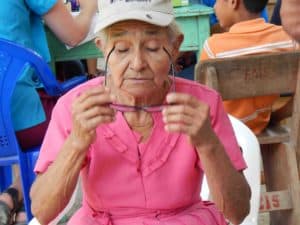
If that is all the Wyoming Brigade does, it’s certainly a great deal. But the generosity extends beyond the clinic and into the homes and lives of the residents of Agua Salada. They came with hygiene supplies. They came with school supplies. They now provide school scholarships for five local children and look to provide more. This is not simply about a generous gift, but rather it is about the commitment of relationship. The University of Wyoming partners with the community of Agua Salada and Shoulder to Shoulder such that enrichment, development, transformation, and meaningful growth are deeply rooted into the hearts of all involved: brigade members, beneficiaries, community leaders, and all who are committed to the relationship.
Later in the day when the lines are receding, the young nursing student who hasn’t gotten much sleep due to the rude roosters, might have slipped away to grab an hour or two siesta. She doesn’t speak Spanish, but all day long she’s been using the international language of play with children. I spy her now with two girls, maybe seven and eight years old. They are fully engrossed in a game of “patty cake” — mimicking, mirroring, and hand slapping. The smiles on their three faces, the sign of commitment and love, are the most powerful medicine that the University of Wyoming has distributed all day.
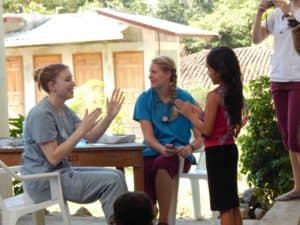
Yo Puedo Retreat 2014
November 19, 2014
This past weekend, a phenomenal event occurred for the Yo Puedo (I Am Able) girls. Yo Puedo is a peer empowerment program for girls in the fifth and sixth grade. In peer reinforced education, they are empowered to learn skills, become responsible, grow in self esteem, and start small businesses that they themselves manage and operate.
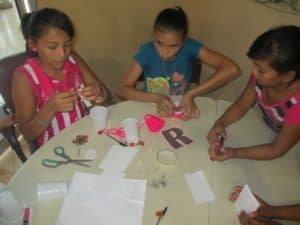
On Saturday, November 15 through Sunday, November 16, eleven girls, representatives from the twelve Yo Puedo sites from the many towns and villages of the Intibucá frontier region, came together for their second annual retreat at the Santa Lucia Clinic. Grateful for the support of teachers, parents and administrative personal from Shoulder to Shoulder, the girls celebrated successes of the past year and looked forward to new events for this coming one.
The girls received permission from their parents. A hired car drove across the frontier region, collecting girls from the various schools. They were ecstatic to see the car, confirming the reality of the retreat. Arriving in Santa Lucia Clinic around midday, the girls ran desperately to reserve their beds, covering them with personal items. A few minutes to rest, then onto lunch.
After lunch, the activities commenced. The girls introduced themselves and participated in several activities, each with its own special lesson. The “Birthday Line,” for example, had the girls line up according to their birthdays. Without using any words, this was comical, but it also demonstrated the importance of non-verbal communication and teamwork. For the activity “Treasure Bag,” two groups were given a bag including paper, crayons and markers, masking tape, scissors, with other items, and were asked to create something meaningful. They organized themselves around the project, demonstrated flourishing creativity, and recognized that each girl had a specific, critical role to play in the process.
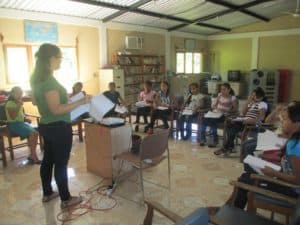
Near the end of the retreat, a few videos on self-esteem and goal setting fueled discussion about the girls’ short and long-term goals. The success of the retreat was evidenced by how well the girls came together and found their voice.
Minsis Ramos Diaz, Coordinator for Yo Puedo, is grateful to the generous hearts of sponsors. The unconditional support is truly what our young people need. The girls are taking to heart the power of the simple phrase, “I Am Able.”
Hope and Pride
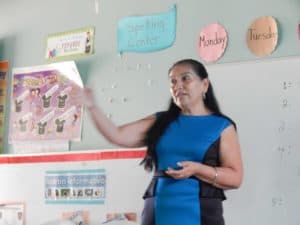
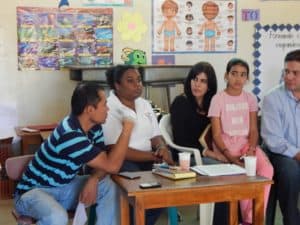
November 16, 2014
No one from my family had ever been to college. My dad was a truck driver who never finished high school. I recall vividly my father’s beaming expression, a mixture of hope and pride, the day he dropped me off at the University of Massachusetts. Yesterday, I sat in on the parents meeting at the Bilingual School of the Good Shepherd in Camasca, Intibucá. As I looked out upon those attending I experienced that eerie sense of déjà vu. Thirty-six years later, it was my father looking back at me with that same expression of hope and pride.
How different are the families here in Honduras, yet one thing is certainly universal. Parents want so much more for their children than they themselves obtained. Education, a quality education, is the key element to realize that goal. Education, a quality education, is simply not accessible to the great majority of Honduran families. Why hope, if hope yields disappointment? Perhaps it is better to take pride in more modest achievements. This must be the thoughts of most families raising children in Honduras. Those thoughts seem to be changing in the frontier region of Intibucá.
In 2012, Shoulder to Shoulder, the community of the Good Shepherd Catholic Church in Cincinnati, and the families of the frontier region of Intibucá dared to dream of a financially accessable, quality, bilingual school. The classrooms were designed and erected and today it is a reality with fifty-four students in kindergarten, first and second grade. It is a public school, available to everyone.
Public education has been a disaster in Honduras. There simply aren’t the resources. The buildings are not maintained, materials are non-existent, the teachers are minimally qualified, and the list goes on. Maybe Honduras needs to think about a new model. What about a partnership among the Department of Education, a committed NGO like Shoulder to Shoulder, the surrounding municipalities, and the parents themselves? There you have it, the Good Shepherd Bilingual School. This model school is a first in Honduras. There are a great many challenges that face the parents and partners of this endeavor. But it is only with great risk that great reward can be achieved.
Attorneys Plutarco Rivera and his wife Patricia Maria Sikaffy, were present at the meeting to present the proposed agreement for the foundation of the model, bilingual, public school. Attorney Rivera exhorted those present that if this “experiment” is to have success, it will be dependent upon the dedicated involvement of the parents as represented in their committee. In those expressions of hope and pride, another emotion was palpably present. These parents are determined; determined that their children will have an education that will place them on the path of success and fulfillment. In a few weeks on this website, there will be opportunity to support the parents’ determination by financially sponsoring one of their children. It will be a tremendous opportunity to ally ourselves with a phenomenal moment of transformation.
May these expressions of hope and pride be the force that yields enrichment!
